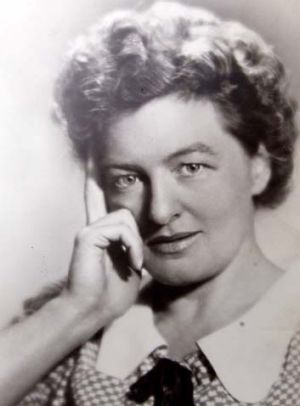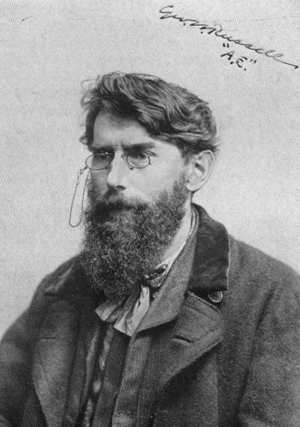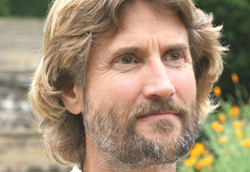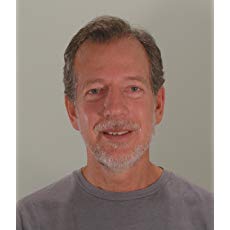The Occult World of Pamela Travers
Printed in the Spring 2019 issue of Quest magazine.
Citation: Paul V., Young,"The Occult World of Pamela Travers" Quest 107:2, pg 35-38
By Paul V. Young
 The masterfully told stories of a magical nanny that held adults and children alike spellbound for decades might incline readers to think that Australian author Pamela (P.L.) Travers merely had an overactive imagination. The truth is that her talent blossomed out of a fertile garden of occult teachings and paranormal experiences, nurtured and inspired by some exceptionally gifted personalities in real life. The movie Saving Mr. Banks and the documentary The Real Mary Poppins have treated the public to insights on her relationship with her father, the influence of the aunt she called Sass, and her tumultuous association with Walt Disney. Of equal gravity was her lifelong attraction to mystical pursuits and the guidance of the philosopher and mystic G.I. Gurdjieff.
The masterfully told stories of a magical nanny that held adults and children alike spellbound for decades might incline readers to think that Australian author Pamela (P.L.) Travers merely had an overactive imagination. The truth is that her talent blossomed out of a fertile garden of occult teachings and paranormal experiences, nurtured and inspired by some exceptionally gifted personalities in real life. The movie Saving Mr. Banks and the documentary The Real Mary Poppins have treated the public to insights on her relationship with her father, the influence of the aunt she called Sass, and her tumultuous association with Walt Disney. Of equal gravity was her lifelong attraction to mystical pursuits and the guidance of the philosopher and mystic G.I. Gurdjieff.
Travers was born in Maryborough, Queensland, as Helen Lyndon Goff in 1899. Her father, Travers Robert Goff, whom she adored, moved the family to the small community of Allora on the Darling Downs in 1905, where he died of tuberculosis at the age of forty-three. It was then that Christina Saraset, or Aunt Sass, as she liked to be called, came on the scene to help out, and Pamela and her family moved once again, this time to Bowral in New South Wales.
It is now common knowledge that the character of Mr. Banks in her novels was based on her father, while Aunt Sass, who “flew in from the east,” would serve as the model for Mary Poppins, who famously blew in from the east with her parrot umbrella and magical carpetbag. The real-life Aunt Sass was a strong, no-nonsense presence in her niece’s life, as well as her work. Travers described her as a “bulldog with a ferocious exterior” but with a “heart tender to the point of sentimentality.”
 |
|
| Pamela Travers |
Travers has been described by some observers as “mysterious and prickly,” and one could form the opinion, based on Emma Thompson’s portrayal of her in Saving Mr. Banks—as praiseworthy as it was from an artistic point of view—that the writer was full of herself, close-minded, and perhaps even emotionally cold. This notion might be further reinforced by the fact that she never married, bore children of her own, or formed a family unit in the conventional sense. Yet such an impression would be completely false.
As a young woman Helen Goff was an actress, dancer, and poet before turning her hand to journalism. She toured Australia and New Zealand as a member of Allan Wilkie’s Shakespearean Company, adopting the stage name Pamela Lyndon Travers. At the age of twenty-four she traveled to Ireland, where the Irish poet, mystic, and Theosophist George Russell (AE) would become her mentor. As editor of The Irish Statesman, Russell, whose kindness towards younger writers was legendary, initially accepted some of her poems for publication. From 1925 onward, she was introduced to Theosophical thought and to literary figures familiar with the Theosophical Society, including T.S. Eliot, Oliver St. John Gogarty, and William Butler Yeats, the latter being one of the leaders of the Hermetic Order of the Golden Dawn.
Gurdjieff, Mysticism, and Spirituality
 |
|
| The Irish author George Russell, who wrote under the pen name AE. |
Travers had studied the Gurdjieff system under his pupil Jane Heap, and in March 1936, with the help of Jessie Orage (widow of the editor and critic A.R. Orage, another student of Gurdjieff’s), she met Gurdjieff, who in turn introduced her to the paths of Sufism and Zen. He encouraged her to explore Eastern religion and during her thirties and forties, she delved into Buddhism, later gravitating to Jiddu Krishnamurti.
As a successful writer, Travers traveled to New York City during World War II while working for the British Ministry of Information. At the invitation of her friend, the U.S. Commissioner of Indian Affairs, John Collier, Travers spent two summers living among the Navajo, Hopi, and Pueblo Indians, studying their mythology and folklore. Episodes such as these reveal something of her true character and her perpetual thirst for knowledge of the occult and esoteric. She had no qualms about lodging at a reservation and formed a close bond with the Navajo people in Arizona, who did the honor of bestowing an Indian name on her, although it was one that she always kept secret. After the war, she remained in the U.S. and became writer-in-residence at Radcliffe College, Smith College.
Journalist and critic Jerry Griswold, in an essay tribute to Travers published after her death, asserted that she had “lived for several years” with the Navajos and, during another period, had “studied for several years” in Kyoto under a Zen master, although in his recollections he probably exaggerated the time spans somewhat. After her American sojourn, she returned to England, making only one brief visit to Sydney in 1960 while on her way to Japan to study Zen.
Arcane Influences and Didactic Writings
To what degree were Travers’ writings influenced, guided or even manipulated by her spiritual masters? She met Gurdjieff some years after the first edition of Mary Poppins had been published in 1934, followed by the equally well-received Mary Poppins Comes Back (1935). Any direct influence by Gurdjieff is more likely to be found in the later Mary Poppins books, particularly Mary Poppins Opens the Door (1944) and Mary Poppins in the Park (1952).
In 1970 Travers authored a contribution on Gurdjieff for the encyclopedia Man, Myth, and Magic, edited by Richard Cavendish, then went on to publish an insightful ten-page booklet, George Ivanovich Gurdjieff, three years later. In that tract she reflects on the various traditions that were woven into Gurdjieff’s work and, by extension, her own thought and philosophy:
What was the source of his teaching? True to his role, Gurdjieff never openly disclosed it. By examining his writings and the numerous commentaries upon them it might be possible to discover parallels in various traditions: Tantric Buddhism, Hinduism, Sufism, Greek Orthodoxy—possible, but hardly profitable. For the fundamental features of his method cannot be traced to any one source. [P.D.] Ouspensky quotes him as admitting, I will say that, if you like, this is esoteric Christianity. There seems no reason to reject this when one remembers that Christianity, as Gurdjieff knew it, was the heir of the ages and must have drawn to itself elements from very early pre-Christian traditions, Hittite, Assyrian, Phrygian, Persian; and there is nothing so explosive as old ideas restated in contemporary terms as the Western world was to discover when Gurdjieff burst upon it.
In the same publication she lists several celebrated editors and writers of the day who socialized with Gurdjieff at his “great feasts where, under the influence of good food, vodka and the watchful eye of the Master, opportunities were provided, for those who had the courage, to come face to face with themselves. The hardiest among them, those who could rise to the level of being serious, were allowed to transmit something of the teaching to newer pupils.”
This issue of the transmission of the teachings poses the further question of whether Travers’s novels carried veiled arcane messages intended only for the more astute and esoterically inclined among her audience. We should, nevertheless, resist the temptation to read too much of Gurdjieff into the Mary Poppins stories. In an interview which appeared in The Paris Review in 1982, the interviewers asked Travers whether “Mary Poppins’ teaching—if one can call it that—resemble that of Christ in his parables. Travers replied:
My Zen master, because I've studied Zen for a long time, told me that every one (and all the stories weren’t written then) of the Mary Poppins stories is in essence a Zen story. And someone else, who is a bit of a Don Juan, told me that every one of the stories is a moment of tremendous sexual passion, because it begins with such tension and then it is reconciled and resolved in a way that is gloriously sensual.
The answer is clarified by the following question posed by the interviewer: “So people can read anything and everything into the stories?”Travers’ response: “Indeed.”
In Man, Myth, and Magic, Pamela Travers wanted to make it clear that that the work of her master in no way constituted black magic. She wrote:
It is clear from Gurdjieff's writings that hypnotism, mesmerism and various arcane methods of expanding consciousness must have played a large part in the studies of the Seekers of Truth [a group Gurdjieff said he had belonged to in his youth]. None of these processes, however, is to be thought of as having any bearing on what is called Black Magic, which, according to Gurdjieff, “has always one definite characteristic. It is the tendency to use people for some, even the best of aims, without their knowledge and understanding, either by producing in them faith and infatuation or by acting upon them through fear. There is, in fact, neither red, green nor yellow magic. There is ‘doing.’ Only ‘doing’ is magic.” Properly to realise the scale of what Gurdjieff meant by magic, one has to remember his continually repeated aphorism, “Only he who can be can do,” and its corollary that, lacking this fundamental verb, nothing is “done,” things simply “happen.”
Travers insisted that the Mary Poppins stories had not come from herself, but that there are “ideas floating around that pick on certain people.” She believed that her books were gifts of Go, “given” to her, and quoted C. S. Lewis saying, “There is only one Creator, we merely mix the ingredients He gives us.” She declared that she was not a creator, but simply a vessel and never wrote specifically for children but was “grateful that children have included my books in their treasure trove.”
What the Bee Knows
In addition to her well-known collection of novels, Travers wrote numerous nonfictional essays and books, especially in her later years. What the Bee Knows is a collection of spiritual essays. The back of the book describes it as “a honeycomb of essays pointing to the truth-of-things handed down in the great popular stories of cultures around the world.” And that is just what it is—a labyrinth of brief dissertations covering a range of esoteric, myth-based, and biographical themes. She shares tales of her friendships with literary figures such as Yeats and Russell, of her studies among many religions of the world, of her early experience with fairy tale and folklore, which shaped her character.
The Sphinx, the Pyramids, the stone temples are, all of them, ultimately, as flimsy as London Bridge; our cities but tents set up in the cosmos. We pass. But What The Bee Knows, the wisdom that sustains our passing life—however much we deny or ignore it—that for ever remains.
Why did Travers choose the bee as her metaphor? She wrote:
I thought of [Karl] Kerenyi—“Mythology occupies a higher position in the bios, the Existence, of a people in which it is still alive than poetry, storytelling or any other art.” And of [Bronislaw] Malinowski—“Myth is not merely a story told, but a reality lived.” And, along with those, the word “Pollen,” the most pervasive substance in the world, kept knocking at my ear. Or rather, not knocking, but humming. What hums? What buzzes? What travels the world? Suddenly I found what I sought. “What the bee knows,” I told myself. “That is what I’m after.”
But even as I patted my back, I found myself cursing, and not for the first time, the artful trickiness of words, their capriciousness, their lack of conscience. Betray them and they will betray you. Be true to them and, without compunction, they will also betray you, foxily turning all the tables, thumbing syntactical noses. For—nota bene!—if you speak or write about What The Bee Knows, what the listener, or the reader, will get—indeed, cannot help but get—is Myth, Symbol, and Tradition! You see the paradox? The words, by their very perfidy—which is also their honourable intention—have brought us to where we need to be. For, to stand in the presence of paradox, to be spiked on the horns of dilemma, between what is small and what is great, microcosm and macrocosm, or, if you like, the two ends of the stick, is the only posture we can assume in front of this ancient knowledge—one could even say everlasting knowledge.
An Esoteric and Occult Bequest
Toward the end of her life Travers became increasingly interested in Sufism, a form of Islamic mysticism, particularly its Persian branch, through meetings with members of the fraternity and their publications in Britain. We can assume that she continued her search for life’s meaning among the world’s mystical and spiritual traditions right until the end. Perhaps she never felt she had reached the ultimate aim of Gurdjieff’s Work or Fourth Way, which held the goal of shattering one’s pretensions and ego, or the stripping away of the egocentric personality and awakening to a higher consciousness.
It is no secret that the great success of author J.K. Rowling, with that other fictional champion of magic in book and film, Harry Potter, owes something to Travers. Rowling was an admirer of Travers and adopted both her enigmatic disguise in initialing her first names and also the theme of flight, just as Travers had herself been inspired by J.M. Barrie’s Peter Pan. She also borrowed the name when she created the character of the Death-Eater wizard called Travers in her novels. Rowling now ranks highly in the tradition of authors of youth fantasy classics, joining C.S. Lewis, J.R.R. Tolkien, J.M. Barrie and, of course, Travers.
In 1977 Travers was made an Officer of the Order of the British Empire and in 1978 received an honorary degree from Chatham College in Pittsburgh. She would spend the final years of her life in London’s Chelsea district, dying from the effects of an epileptic seizure on April 23, 1996, at the age of ninety-six. What she contributed to literature is now legendary. What she bequeathed us in the way of mystical knowledge ought not be underestimated either. Her lifelong pursuit of spiritual wisdom enriched the storehouse of esoteric teachings available to all those she called the “Seekers of Truth.”
Paul V. Young is a writer and author as well as a certified practitioner of Reiki, neurolinguistic programming, and the Law of Attraction. He lives on the Gold Coast of Australia and publishes the monthly online magazine AustralianEsoteric.com. His blog is www.SolarAncestor.com. This article was originally published in New Dawn magazine.


 H.P. Blavatsky (1831–91), HPB, as we call her, is the one of the few nineteenth-century esoteric authors widely remembered today. She is, of course known to Theosophical Society members, but not always read by them. Only in recent decades have her (almost) complete works become widely available. Some of her essays and reviews were long out of print until included in the Collected Writings, edited by Boris de Zirkoff and published between 1966 and 1991. The standard edition of her letters is still in progress. There are varying versions of her Esoteric Instructions.
H.P. Blavatsky (1831–91), HPB, as we call her, is the one of the few nineteenth-century esoteric authors widely remembered today. She is, of course known to Theosophical Society members, but not always read by them. Only in recent decades have her (almost) complete works become widely available. Some of her essays and reviews were long out of print until included in the Collected Writings, edited by Boris de Zirkoff and published between 1966 and 1991. The standard edition of her letters is still in progress. There are varying versions of her Esoteric Instructions. Theosophy, while not a religion but a search for truth, draws heavily from Buddhist insights. Buddhism, like Theosophy and most religions, is a system of teachings aiming to assist its adherents to attain spiritual enlightenment. The underlying idea is that as we cultivate our awareness and awaken spiritually, we naturally help to bring healing and harmony not just to ourselves, but also to our society.
Theosophy, while not a religion but a search for truth, draws heavily from Buddhist insights. Buddhism, like Theosophy and most religions, is a system of teachings aiming to assist its adherents to attain spiritual enlightenment. The underlying idea is that as we cultivate our awareness and awaken spiritually, we naturally help to bring healing and harmony not just to ourselves, but also to our society. I came to the Quakers out of need, but stayed because I found something I’d lost.
I came to the Quakers out of need, but stayed because I found something I’d lost.